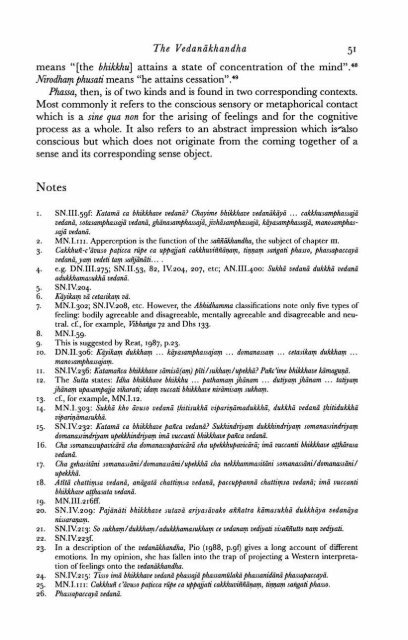Identity and Experience_Hamilton_1996
Identity and Experience_Hamilton_1996
Identity and Experience_Hamilton_1996
You also want an ePaper? Increase the reach of your titles
YUMPU automatically turns print PDFs into web optimized ePapers that Google loves.
The Vedana'kh<strong>and</strong>ha<br />
means "[the bhikkhu] attains a state of concentration of the mind".48<br />
Nirodham phusati means "he attains ces~ation".~~<br />
Pha, then, is of two kinds <strong>and</strong> is found in two corresponding contexts.<br />
Most commonly it refers to the conscious sensory or metaphorical contact<br />
which is a sine qua non for the arising of feelings <strong>and</strong> for the cognitive<br />
process as a whole. It also refers to an abstract impression which is~also<br />
conscious but which does not originate from the coming together of a<br />
sense <strong>and</strong> its corresponding sense object.<br />
Notes<br />
SN. 111.591' iiatami ca bhikkhave ved<strong>and</strong>? Chayime bhikkhave vedanikiiyi . . . cakkhusamphassaji<br />
vedani, sotasamfihmrajti vedani, ghinmamphmajti, jivhii.samphmsaj5, kiyasamphau'aji, manosamphassujh-<br />
vedani.<br />
MN.1.111. Apperception is the function ofthe saiiiia<strong>and</strong>ha, the sub-ject of chapter 111.<br />
Cakkhuii-cJivuso pa+cca riipe ca uppajati cakkhuviiiiiiyzm, tinnam sarigati phauoJ phassapaccayi<br />
vedani, yam vedeti tam saiijdniti.. . .<br />
e.g, DN.III.275; SN.II.53, 82, IV.204, 207, etc; AN.111.400: Suklti vedani dukkhi vedani<br />
adukkhamasukhi ved<strong>and</strong>.<br />
SN.IV.204.<br />
k2yikap vi cetarikam vi.<br />
MN.1.302; SN.IV.208, etc. However, the Abhidhamma classifications note only five types of<br />
feeling: bodily agreeable <strong>and</strong> disagreeable, mentally agreeable <strong>and</strong> disagreeable <strong>and</strong> neutral.<br />
cf:, fbr example, Ebhariga 72 <strong>and</strong> Dhs 133.<br />
MN.I.59.<br />
This is suggested by Reat, 1987, p.23.<br />
DN.11.306: Kiiyikam dukkham .. . kiiymamphassajam ... domanmsam .. . cetasikam dukkham .. .<br />
manosamphajam.<br />
SN.IV.236: Katamaiica bhikkhave sdmisi(am) piti/sukham/upekhakha? Paiic'ime bhiWchave kiimagu@.<br />
The Sutta states: Idha bhikkhave bhikkhu . . . pathamam jhiinum . . . duriyam jhinam . . . taCiyam<br />
jknam upmampaja viharati; idam vuccati bhikWlave nirimisam sukham.<br />
cf., for example, MN.I.12.<br />
MN.1.303: Sukhi kho dvuso vedani thitisukhi viparindmadukkhii, dukkhii vedani fhitidukkha<br />
uz)ariniimasukhd.<br />
SN.IV.232: Katamd ca bhikkhave paiica vedani? Sukhindriyam dukkhindnyam somanassindnyam<br />
domanasrindnyam uflekkhindriyam imd vuccanti bhikkhave paiica vedani.<br />
Cha .romanmupavicdri cha domanarsu~avuird cha upekkhupaviciri; imi vuccanti bhikkhave atthrura<br />
vedani.<br />
Cha gehasitini somanacrdni/domana,~'dni/u~ekkhi cha nekkhammasitini somanm.riini/domanmsini/<br />
upekkhi.<br />
Atiti chattimsa vedani, <strong>and</strong>gatd chattim.ra ved<strong>and</strong>, paccuppanni chattimsa vedani; imi vuccanti<br />
bhikkhave atthasata ved<strong>and</strong>.<br />
MN.111.216E<br />
SN.IV.209: Pajdndti bhikkhave sutavi ariyasivako aiiffatra kimasuklzi dukkhqa vedaniya<br />
nkara~m.<br />
SN. IV, 2 I 3: So sukham /duWcham /adukkhammukham ce vedanam vedeati ui~afiffutto nam vedeati.<br />
SN.IV.223f:<br />
In a description of the vedanikh<strong>and</strong>ha, Pio (1988, p.gf) gives a long account of different<br />
emotions. In my opinion, she has fallen into the trap of' projecting a Western interpretation<br />
of feelings onto the vedamikh<strong>and</strong>ha.<br />
SN. IV.2 15: Tixro imi bhikkhave vedani /hux~aji fihmamzilakii fihmanidini Pkuapaccayi.<br />
MN. I. I I I: Cakkhuii c'ivwo pakca nipe ca uppajati caMuviiiiiipam, t i ~ sarigati m pho.<br />
Phmapaccqi ved<strong>and</strong>.


